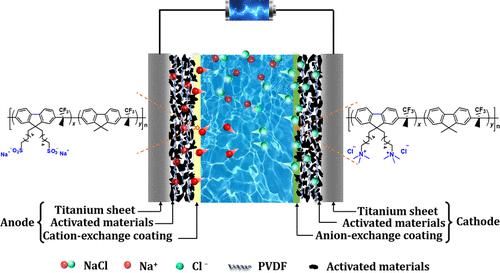当前位置:
X-MOL 学术
›
Ind. Eng. Chem. Res.
›
论文详情
Our official English website, www.x-mol.net, welcomes your
feedback! (Note: you will need to create a separate account there.)
Poly(arylene alkylene)-Based Ion-Exchange Polymers for Enhancing Capacitive Desalination Capacity and Electrode Stability
Industrial & Engineering Chemistry Research ( IF 3.8 ) Pub Date : 2023-08-28 , DOI: 10.1021/acs.iecr.3c02238 Yingsheng Xu 1, 2 , Tao Jiang 1, 3 , Xinyuan Zhang 1, 2 , Guoxin Cao 4 , Lv Yang 4 , Haibing Wei 3, 5 , Hongjian Zhou 1, 2
Industrial & Engineering Chemistry Research ( IF 3.8 ) Pub Date : 2023-08-28 , DOI: 10.1021/acs.iecr.3c02238 Yingsheng Xu 1, 2 , Tao Jiang 1, 3 , Xinyuan Zhang 1, 2 , Guoxin Cao 4 , Lv Yang 4 , Haibing Wei 3, 5 , Hongjian Zhou 1, 2
Affiliation

|
Membrane capacitive deionization (MCDI) has emerged as a promising technique for desalination due to the merits of high capacity, low energy consumption, and high energy efficiency. However, normal free-standing ion-exchange membranes are used in MCDI, and they usually have the drawbacks of high thickness and cost, limiting their large-scale application in industrial promotion. Here, we report a scalable, continuous processing strategy to produce MCDI electrodes for enhancing capacitive desalination capacity and electrode stability, in which the carbon electrodes are coated using poly(arylene alkylene)-based ion-exchange polymers. The MCDI based on integrated ion-exchange polymer-coated membrane electrodes (C-MCDI) delivered a high salt adsorption capacity of up to 23.7 mg g–1 and an excellent charge efficiency of up to 98%, far higher than that of membrane-free CDI with bare carbon electrodes and MCDI with free-standing membrane-based carbon electrodes (FS-MCDI). The COMSOL simulation demonstrated that the coated ion-exchange membrane in C-MCDI was more effective for reducing the interface contact resistance between the carbon and ion-exchange membrane and enhancing the ion transportation. Furthermore, the C-MCDI device showed a long lifespan with a stable desalination capacity of around 18.6 mg g–1 after 500 cycles; instead, the capacity continuously attenuated to near zero in CDI with bare carbon electrodes. Hence, this work proposed two novel polymer-based ion-exchange materials for scalable fabrication of high-performance MCDI electrodes via an environmentally friendly, cost-effective, and process-integrated method.
中文翻译:

用于增强电容式海水淡化能力和电极稳定性的聚(亚芳基亚烷基)基离子交换聚合物
膜电容去离子(MCDI)由于具有高容量、低能耗和高能源效率的优点,已成为一种有前景的海水淡化技术。然而,MCDI采用的是普通的自支撑式离子交换膜,通常存在厚度高、成本高的缺点,限制了其在工业推广中的大规模应用。在这里,我们报告了一种可扩展的连续加工策略,用于生产 MCDI 电极,以增强电容式海水淡化能力和电极稳定性,其中碳电极使用基于聚(亚芳基亚烷基)的离子交换聚合物进行涂层。基于集成离子交换聚合物涂层膜电极 (C-MCDI) 的 MCDI 具有高达 23.7 mg g –1的高盐吸附能力充电效率高达98%,远高于裸碳电极无膜CDI和独立式膜基碳电极MCDI(FS-MCDI)。COMSOL模拟表明,C-MCDI中的涂层离子交换膜能够更有效地降低碳与离子交换膜之间的界面接触电阻,增强离子传输。此外,C-MCDI 装置具有较长的使用寿命,稳定的脱盐能力约为 18.6 mg g –1500次循环后;相反,在使用裸碳电极的 CDI 中,容量不断衰减至接近于零。因此,这项工作提出了两种新型聚合物基离子交换材料,通过环保、经济高效和工艺集成的方法可规模化制造高性能 MCDI 电极。
更新日期:2023-08-28
中文翻译:

用于增强电容式海水淡化能力和电极稳定性的聚(亚芳基亚烷基)基离子交换聚合物
膜电容去离子(MCDI)由于具有高容量、低能耗和高能源效率的优点,已成为一种有前景的海水淡化技术。然而,MCDI采用的是普通的自支撑式离子交换膜,通常存在厚度高、成本高的缺点,限制了其在工业推广中的大规模应用。在这里,我们报告了一种可扩展的连续加工策略,用于生产 MCDI 电极,以增强电容式海水淡化能力和电极稳定性,其中碳电极使用基于聚(亚芳基亚烷基)的离子交换聚合物进行涂层。基于集成离子交换聚合物涂层膜电极 (C-MCDI) 的 MCDI 具有高达 23.7 mg g –1的高盐吸附能力充电效率高达98%,远高于裸碳电极无膜CDI和独立式膜基碳电极MCDI(FS-MCDI)。COMSOL模拟表明,C-MCDI中的涂层离子交换膜能够更有效地降低碳与离子交换膜之间的界面接触电阻,增强离子传输。此外,C-MCDI 装置具有较长的使用寿命,稳定的脱盐能力约为 18.6 mg g –1500次循环后;相反,在使用裸碳电极的 CDI 中,容量不断衰减至接近于零。因此,这项工作提出了两种新型聚合物基离子交换材料,通过环保、经济高效和工艺集成的方法可规模化制造高性能 MCDI 电极。





















































 京公网安备 11010802027423号
京公网安备 11010802027423号